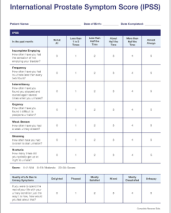The iTind procedure delivers rapid relief of enlarged prostate symptoms through a clinically-proven, minimally invasive outpatient treatment.
The iTind procedure reshapes the prostate, creating a wider opening for urine to flow freely, without burning or cutting out prostate tissue, and without leaving behind a permanent implant.1,2
Implantation of the iTind device may cause urinary urgency, pelvic discomfort, dysuria or hematuria. In rare cases, the iTind procedure may cause urinary tract infection or acute urinary retention.
1. Amparore D, Fiori C, Valerio M, et al. 3-Year results following treatment with the second generation of the temporary implantable nitinol device in men with LUTS secondary to benign prostatic obstruction. Prostate Cancer Prostatic Dis. 2020.
2. Chughtai B, Elterman D, Shore N, et al. The iTind Temporarily Implanted Nitinol Device for the Treatment of Lower Urinary Tract Symptoms Secondary to Benign Prostatic Hyperplasia: A Multicenter, Randomized, Controlled Trial. Urology. 2020.
Why Choose the iTind Procedure?
The iTind procedure is an alternative to prescription medication or invasive surgery.
Key Benefits
Rapid symptom relief1,2,3
Preserves sexual and ejaculatory function2,3
Temporary implant removed after 5 to 7 days
Low post-op catheterization
Typically you go home without a catheter after the implant procedure as well as the removal procedure. In rare cases, acute urinary retention may occur, requiring insertion of a catheter.1
Clinical studies show symptomatic relief for at least 4 years.4
1. Amparore D, Fiori C, Valerio M, et al. 3-Year results following treatment with the second generation of the temporary implantable nitinol device in men with LUTS secondary to benign prostatic obstruction. Prostate Cancer Prostatic Dis. 2020.
2. Chughtai B, Elterman D, Shore N, et al. The iTind Temporarily Implanted Nitinol Device for the Treatment of Lower Urinary Tract Symptoms Secondary to Benign Prostatic Hyperplasia: A Multicenter, Randomized, Controlled Trial. Urology. 2020.
3. De Nunzio C, Cantiello F, Fiori C, et al. Urinary and sexual function after treatment with temporary implantable nitinol device (iTind) in men with LUTS: 6-month interim results of the MT-06-study. World J Urol. 2020.
4. Amparore D, De Cillis S, Schulman C, Kadner G, Fiori C, Porpiglia F. Temporary implantable nitinol device for benign prostatic hyperplasia-related lower urinary tract symptoms: over 48-month results. Minerva Urol Nephrol. 2023 Jun 23. doi: 10.23736/S2724-6051.23.05322-3. Epub ahead of print. PMID: 37350585.
Ask your doctor about the iTind procedure if you do not want to take a pill every day, or if you have tried standard drug treatments and did not have the reduction in symptoms you wanted or are unhappy with the way they made you feel. The iTind procedure might also be the right choice for you if you are interested in preserving your sexual function, are worried about having a permanent implant, or are concerned about undergoing a surgery that would involve a long recovery and downtime.
As with any medical procedure, individual results vary. Men with moderate to severe BPH symptoms are generally good candidates for the procedure. Speak with your doctor to see if the iTind procedure is right for you.
What are the risks?
The iTind procedure is a safe and effective treatment for BPH in men age 50 and older. Some patients experience side effects during the procedure, but they are generally only mild to moderate. Side effects, if experienced, include pain or burning with urination, blood in the urine, pelvic pain, an urgent need to urinate and/or the inability to control the urge. Most of these side effects occur during the 5 to 7 day treatment period and resolve shortly after the device is removed.
Testimonials

"The iTind procedure is a perfect fit for patients that do not want to be on continued prescription BPH medication, do not want a permanent device implanted or are not yet ready for surgery."
— Dr. Kenneth Kernen, Troy, Michigan
Recorded November 2021
Dr. Kernen is a paid consultant to Olympus Corporation of the Americas.




"It’s been 15 months since the iTind™ procedure. The first time I urinated I was amazed. I felt like I was 16 years old again."
— Jim, iTind Procedure Patient
Recorded November 2021
Jim was treated with the iTind procedure and is an unpaid speaker. As with any product, results may vary.
The iTind procedure is intended for the treatment of symptoms due to urinary outflow obstruction secondary to benign prostatic hyperplasia (BPH) in men age 50 and above.
It is important to note that results from the iTind procedure may vary and not all patients see benefit from this treatment. As with all medical procedures results may vary. Patients should consult with their physician to determine their course of treatment.
Implantation of the iTind device may cause pelvic discomfort, blood in urine, painful or urgent urination. In rare cases, the iTind device may cause urinary tract infection or a sudden difficulty to urinate.
Dr. Naveen Kella Discusses the iTind Treatment
Naveen Kella, MD is a paid consultant to Olympus Corporation of the Americas.
Recorded February, 2022
FAQs
What is the iTind procedure?
The iTind procedure is a 5 to 7 day treatment for lower urinary tract symptoms (LUTS) due to benign prostatic hyperplasia (BPH), or enlarged prostate.
How does the iTind procedure work?
The iTind device is placed in the prostate and stays in place for about a week. During this time, the iTind device slowly expands to widen the opening through which urine flows. At the end of the treatment, the iTind device is completely removed. There is no permanent implant or heat treatments. No prostate tissue is removed and initial studies have shown there is no impact on sexual function.1,2
How do I know if the iTind procedure is right for me?
The iTind procedure is an alternative to prescription medication or invasive surgery. Ask your doctor about the iTind procedure if you do not want to take a pill every day, or if you have tried standard drug treatments and were unsatisfied with the level of symptomatic relief or the way they made you feel. The iTind procedure might also be the right choice for you if you are interested in preserving your sexual function and continence1,2, are worried about having a permanent implant, or are concerned about undergoing a surgery that would involve a long recovery and downtime.
What can I expect during the iTind procedure?
Your doctor will insert the iTind device into the prostatic urethra in the hospital or clinic. Patients rarely go home with a catheter.1 After 5 to 7 days at home, you will return to your doctor's office and the iTind device will be completely removed. There may be some slight discomfort during the 5 to 7 days, but most patients feel rapid symptomatic relief and return to their normal activities shortly after removal of the iTind device.1,2
Is the procedure painful?
Patient experience is variable. Most patients experience only mild to moderate discomfort with the iTind device is in place.
What are common side effects while the treatment is ongoing?
Implantation of the iTind device may cause pelvic discomfort, blood in urine, painful or urgent urination. In rare cases, the iTind procedure may cause urinary tract infection or a sudden difficulty to urinate.
How long is the recovery period?
After insertion of the iTind device, you may be kept for a few hours for observation. Upon returning home you may resume most normal activities depending on your personal level of comfort and your doctor’s advice.
When will I feel results?
Most patients start to experience symptom relief shortly after the removal.1,2 Symptoms typically continue to improve over the following 6 to 12 weeks.1,2
Are there any side effects after the treatment is complete?
In clinical studies there have been no indications of long-term adverse side effects.3 Since the iTind device is completely removed at the end of the treatment week, there is no risk of implant migration, encrustation, or tissue overgrowth. Moreover, there are no obstacles in maintaining a regular prostate screening program, including physical exams or any type of imaging, such as MRI, if needed.
Will the iTind procedure affect sexual function?
The device positioning helps to ensure that no damage is caused to sperm ducts or sphincters, avoiding risks of sexual dysfunction. In clinical studies, sexual function was preserved among patients treated with the iTind procedure.1,2
Is the treatment permanent?
Durability has been demonstrated in clinical studies out to at least 4 years in terms of symptom improvement and quality of life in a significant number of patients.3 The iTind procedure does not preclude retreatment or other BPH treatments, should they be needed or desired in the future.
Are there any contraindications?
Depending on your medical history and anatomy, the iTind procedure may not be the best treatment for you. Consult with your doctor to determine whether the iTind procedure is right for you.
What clinical data is available on the iTind procedure?
You can read more about the clinical data here.
Where is the iTind procedure available?
The iTind procedure is approved for use in the European Union, UK, Israel, Australia, Brazil, Canada and the USA. Use the Physician Finder to locate a urologist performing the iTind procedure.
1. Amparore D, Fiori C, Valerio M, et al. 3-Year results following treatment with the second generation of the temporary implantable nitinol device in men with LUTS secondary to benign prostatic obstruction. Prostate Cancer Prostatic Dis. 2020.
2. Chughtai B, Elterman D, Shore N, et al. The iTind Temporarily Implanted Nitinol Device for the Treatment of Lower Urinary Tract Symptoms Secondary to Benign Prostatic Hyperplasia: A Multicenter, Randomized, Controlled Trial. Urology. 2020.
3. Amparore D, De Cillis S, Schulman C, Kadner G, Fiori C, Porpiglia F. Temporary implantable nitinol device for benign prostatic hyperplasia-related lower urinary tract symptoms: over 48-month results. Minerva Urol Nephrol. 2023 Jun 23. doi: 10.23736/S2724-6051.23.05322-3.
Resources

If you think you have BPH, you can search here for a physician in your local area, to help determine the right course of treatment for you.
1. Amparore D, Fiori C, Valerio M, et al. 3-Year results following treatment with the second generation of the temporary implantable nitinol device in men with LUTS secondary to benign prostatic obstruction. Prostate Cancer Prostatic Dis. 2020.
2. Chughtai B, Elterman D, Shore N, et al. The iTind Temporarily Implanted Nitinol Device for the Treatment of Lower Urinary Tract Symptoms Secondary to Benign Prostatic Hyperplasia: A Multicenter, Randomized, Controlled Trial. Urology. 2020.
3. De Nunzio C, Cantiello F, Fiori C, et al. Urinary and sexual function after treatment with temporary implantable nitinol device (iTind) in men with LUTS: 6-month interim results of the MT-06-study. World J Urol. 2020.
4. Meditate. (2021). The iTind System: Instructions for Use. Hadera, Israel.
5. How I do it: Same day discharge for transurethral resection of prostate using Olympus PlasmaButton™ and PlasmaLoop™. Available at: http://www.canjurol.com/html/freearticles/JUV23_I5_16_FREE_DrKernenSECURE.pdf







